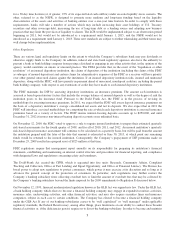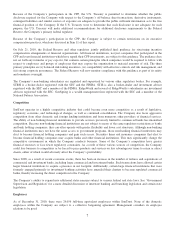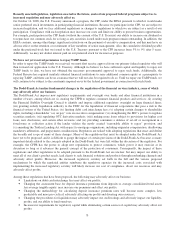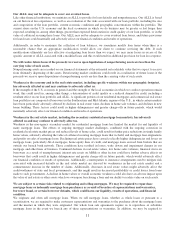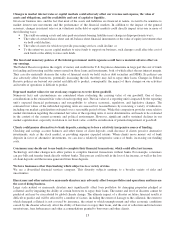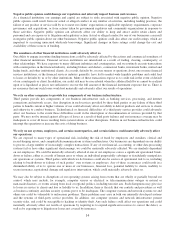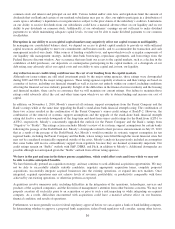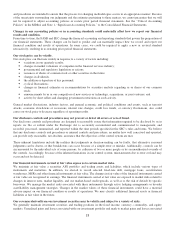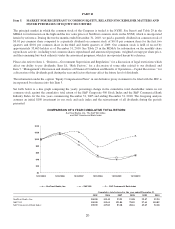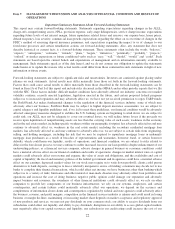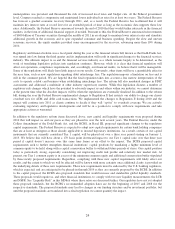SunTrust 2010 Annual Report Download - page 31
Download and view the complete annual report
Please find page 31 of the 2010 SunTrust annual report below. You can navigate through the pages in the report by either clicking on the pages listed below, or by using the keyword search tool below to find specific information within the annual report.We depend on the accuracy and completeness of information about clients and counterparties.
In deciding whether to extend credit or enter into other transactions with clients and counterparties, we may rely on
information furnished by or on behalf of clients and counterparties, including financial statements and other financial
information. We also may rely on representations of clients and counterparties as to the accuracy and completeness of that
information and, with respect to financial statements, on reports of independent auditors.
Industry Risks
Regulation by federal and state agencies could adversely affect the business, revenue, and profit margins.
We are heavily regulated by federal and state agencies. This regulation is to protect depositors, the federal DIF and the
banking system as a whole. The U.S. Congress and state legislatures and federal and state regulatory agencies continually
review banking laws, regulations, and policies for possible changes. Changes to statutes, regulations, or regulatory policies,
including interpretation or implementation of statutes, regulations, or policies, could affect us adversely, including limiting
the types of financial services and products we may offer and/or increasing the ability of nonbanks to offer competing
financial services and products. Also, if we do not comply with laws, regulations, or policies, we could receive regulatory
sanctions and damage to our reputation.
Competition in the financial services industry is intense and could result in losing business or margin declines.
We operate in a highly competitive industry that could become even more competitive as a result of reform of the financial
services industry resulting from the Dodd-Frank Act and other legislative, regulatory and technological changes, and
continued consolidation. We face aggressive competition from other domestic and foreign lending institutions and from
numerous other providers of financial services. The ability of non-banking financial institutions to provide services
previously limited to commercial banks has intensified competition. Because non-banking financial institutions are not
subject to the same regulatory restrictions as banks and bank holding companies, they can often operate with greater
flexibility and lower cost structures. Securities firms and insurance companies that elect to become financial holding
companies, can offer virtually any type of financial service, including banking, securities underwriting, insurance (both
agency and underwriting) and merchant banking, and may acquire banks and other financial institutions. This may
significantly change the competitive environment in which we conduct business. Some of our competitors have greater
financial resources and/or face fewer regulatory constraints, including those competitors that have been able to repay TARP
funds. As a result of these various sources of competition, we could lose business to competitors or be forced to price
products and services on less advantageous terms to retain or attract clients, either of which would adversely affect our
profitability.
Maintaining or increasing market share depends on market acceptance and regulatory approval of new products and
services.
Our success depends, in part, on the ability to adapt products and services to evolving industry standards. There is increasing
pressure to provide products and services at lower prices. This can reduce net interest income and noninterest income from
fee-based products and services. In addition, the widespread adoption of new technologies could require us to make
substantial capital expenditures to modify or adapt existing products and services or develop new products and services. We
may not be successful in introducing new products and services in response to industry trends or developments in
technology, or those new products may not achieve market acceptance. As a result, we could lose business, be forced to price
products and services on less advantageous terms to retain or attract clients, or be subject to cost increases.
Company Risks
We may not pay dividends on your common stock.
Holders of our common stock are only entitled to receive such dividends as our Board may declare out of funds legally
available for such payments. Although we have historically declared cash dividends on our common stock, we are not
required to do so and may reduce or eliminate our common stock dividend in the future. This could adversely affect the
market price of our common stock. Also, our ability to increase our dividend or to make other distributions is restricted due
to our participation in the CPP, which limits (without the consent of the U.S. Treasury) our ability to increase our dividend or
to repurchase our common stock for so long as any securities issued under such program remain outstanding.
Our ability to receive dividends from our subsidiaries could affect our liquidity and ability to pay dividends.
We are a separate and distinct legal entity from our subsidiaries, including the Bank. We receive substantially all of our
revenue from dividends from our subsidiaries. These dividends are the principal source of funds to pay dividends on our
15


